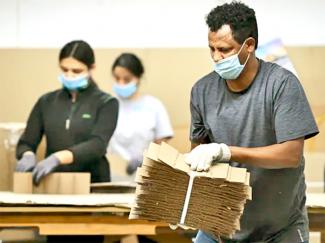‘Heroes’ with issues
Workers say their most important issues missed in covid coverage

DORITOS WEREN’T WORTH THE RISK. That’s the conclusion of one of the retail workers surveyed by a team of Acadia University professors from August to October last year.
The professors asked survey participants if the intense media attention on their work during the pandemic focused on issues most important to them. The answer was “No” from 69 per cent of the workers asked.
Workers unhappy ‘heroes’
One grocery store worker put it this way: “They show us as these lifesavers and glamourize us when in reality, we’re risking our health and safety so Karen can buy Doritos and ice cream at 10 p.m.”
The professors acknowledge the media coverage was not without value. It did sometimes lead to public discussion on work and workplace issues almost never considered: such as, the opportunities and challenges of remote work, the impact of the pandemic on women’s employment and the health and safety of essential workers.
However, the professors found most workers were not happy that the emphasis on them being “heroes” pushed aside needed attention on other “important issues.”
The professors wrote: “...our research shows that there’s a disconnect between the way media covered work issues during the pandemic and the stories workers felt were important for the public to understand.
For example: working-class and racialized people were disproportionately designated “essential,” they were also the least likely to be able to access paid sick leave benefits.
Survey of workers
During the first wave of the pandemic, the research team conducted a survey of three groups of essential workers in Nova Scotia: long-term care workers, retail workers and teachers.
When the team asked survey participants if the media focused on the most important issues of their work, 69 per cent of participants responded “no”.
Broken down by group: retail workers were the most likely to say that the media was not covering the most important issues (75 per cent) followed by teachers (70 per cent) and long-term care workers (58 per cent).
About half of the open-ended responses stated that media coverage was incomplete, one-sided or that the tone became more critical over time. For example, some long-term care workers felt that coverage focused disproportionately on residents, ignoring workers.
The professors report teachers noted that they were often portrayed as complaining, whining or lazy, especially when they expressed concerns about working conditions.
One teacher commented: “It has been interesting to see praises sung as the extent of our jobs was discussed, and then to be referred to in a negative light as we look for clarification of safety measures for returning to school.”
Workers know best
The professors note: “Our participants’ frustrations with media coverage of their work during the first wave of the pandemic underscore the importance of intentionally including workers’ experiences in public dialogue about the economy and public policy.
“After all, workers’ lived experiences are not interchangeable with broader questions about business and the labour market, nor can we understand workers’ experiences through a near exclusive focus on policy. Ignoring workers’ experiences leads to missed opportunities for understanding how policy and working conditions can improve.”
The professors conclude: “In post-pandemic Canada, media will also play a crucial role in shaping public understanding of labour conditions. If we’re committed to creating a future of work that is safe and equitable, workers themselves must be a central voice in the stories that media tell.
- 30 -













Add new comment